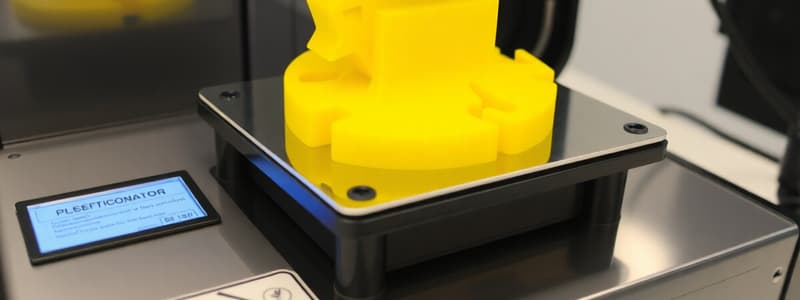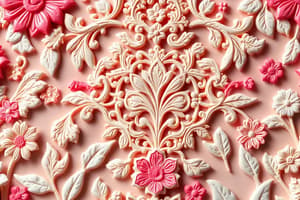Podcast
Questions and Answers
What is the recommended printing speed range?
What is the recommended printing speed range?
- 70-80 mm/s
- 20-30 mm/s
- 100-120 mm/s
- 50-60 mm/s (correct)
The nozzle diameter used in the printing process is 0.5mm.
The nozzle diameter used in the printing process is 0.5mm.
False (B)
What is the purpose of the Layers mode in the view settings?
What is the purpose of the Layers mode in the view settings?
To check the toolpath of the print head for skipped layers or gaps.
The diameter of the selected wire is ____ mm.
The diameter of the selected wire is ____ mm.
What is the recommended temperature for the filament to flow properly?
What is the recommended temperature for the filament to flow properly?
What happens if the file name contains special characters?
What happens if the file name contains special characters?
The factory default voltage setting for the 3D printer is 110V.
The factory default voltage setting for the 3D printer is 110V.
Uniform scaling can be disabled by clicking the lock in the scaling window.
Uniform scaling can be disabled by clicking the lock in the scaling window.
What must be done before inserting the filament into the hotend?
What must be done before inserting the filament into the hotend?
The switch for voltage selection is located on the __________.
The switch for voltage selection is located on the __________.
What driver needs to be installed for online printing?
What driver needs to be installed for online printing?
Match the assembly components with their corresponding installation steps:
Match the assembly components with their corresponding installation steps:
Match the following components with their specifications:
Match the following components with their specifications:
What should you do if you feel resistance while installing the filament?
What should you do if you feel resistance while installing the filament?
Customers can use tweezers to remove the extruded filament before printing.
Customers can use tweezers to remove the extruded filament before printing.
What should be checked to ensure proper installation of the filament?
What should be checked to ensure proper installation of the filament?
What should you do to improve the filament feed?
What should you do to improve the filament feed?
The DMSCREATE DP-X 3D printer can resume printing after a power outage when using both online and offline modes.
The DMSCREATE DP-X 3D printer can resume printing after a power outage when using both online and offline modes.
What is the recommended bottom layer speed to ensure adhesion?
What is the recommended bottom layer speed to ensure adhesion?
To ensure proper extrusion, the nozzle temperature must match the __________.
To ensure proper extrusion, the nozzle temperature must match the __________.
Match the issues with their potential causes:
Match the issues with their potential causes:
Which of the following could cause the first layer not to adhere to the heat bed?
Which of the following could cause the first layer not to adhere to the heat bed?
Using tweezers to remove excessive filament at the nozzle is unnecessary before resuming a print.
Using tweezers to remove excessive filament at the nozzle is unnecessary before resuming a print.
What could be done to help improve filament adhesion if the model area is too small?
What could be done to help improve filament adhesion if the model area is too small?
What could cause gaps or hollow spaces on the top layer of a print?
What could cause gaps or hollow spaces on the top layer of a print?
Increasing the fill value in the slicing software will help eliminate gaps in the printed model.
Increasing the fill value in the slicing software will help eliminate gaps in the printed model.
What is one possible reason for filament grinding during printing?
What is one possible reason for filament grinding during printing?
To resolve layer shifting, one should check the __________ and the driving wheel.
To resolve layer shifting, one should check the __________ and the driving wheel.
Match the issues with their likely causes:
Match the issues with their likely causes:
Which setting in the slicing software could lead to the insufficient flow of filament?
Which setting in the slicing software could lead to the insufficient flow of filament?
A printing speed that is too slow can lead to filament melting.
A printing speed that is too slow can lead to filament melting.
What should be done if the extrusion motor driver is overheating?
What should be done if the extrusion motor driver is overheating?
What could cause stripes or bulge on the surface during printing?
What could cause stripes or bulge on the surface during printing?
Vibration during printing is primarily caused by high printing speeds.
Vibration during printing is primarily caused by high printing speeds.
What should you inspect if the touch screen does not respond?
What should you inspect if the touch screen does not respond?
Wrinkles on the surface can occur due to poor quality filament with an unstable __________.
Wrinkles on the surface can occur due to poor quality filament with an unstable __________.
Match the printing issue with its possible cause:
Match the printing issue with its possible cause:
Which of the following can lead to extruding unevenly?
Which of the following can lead to extruding unevenly?
Rebooting the machine will always resolve a file not printing issue.
Rebooting the machine will always resolve a file not printing issue.
What can cause a print to stop halfway?
What can cause a print to stop halfway?
Which type of laser is primarily used in the automotive industry for cutting and boring?
Which type of laser is primarily used in the automotive industry for cutting and boring?
The Nd:YAG laser is mainly used for cutting wood and plastic materials.
The Nd:YAG laser is mainly used for cutting wood and plastic materials.
What is the classic wavelength of emission for CO2 lasers, typically expressed in micrometers?
What is the classic wavelength of emission for CO2 lasers, typically expressed in micrometers?
CO2 lasers offer a much lower electrical-to-optical conversion efficiency compared to __________ lasers.
CO2 lasers offer a much lower electrical-to-optical conversion efficiency compared to __________ lasers.
Match the types of lasers with their primary usage:
Match the types of lasers with their primary usage:
What is one of the future scopes mentioned for laser cutting technology?
What is one of the future scopes mentioned for laser cutting technology?
Engraving using CNC-controlled lasers requires a resistive mask.
Engraving using CNC-controlled lasers requires a resistive mask.
What gas mixture is primarily responsible for the emission of CO2 lasers?
What gas mixture is primarily responsible for the emission of CO2 lasers?
Flashcards are hidden until you start studying
Study Notes
Safety Instructions
- Be sure to follow all safety instructions listed
- The text provides no further information on safety instructions.
Technical Specification
- Temperature Parameter: Provides information on the temperature settings necessary for printing.
- Software Parameter: Includes details on the software settings used to control the printing process.
- Electrical: Specifies the electrical requirements of the 3D printer.
- Physical Parameter: Provides information on the physical dimensions and components of the device.
Product Overview
- Provides information about the 3D printer.
- Includes a description of the printer's features and capabilities.
Menu Directory
- The menu directory provides information on the different menu options that can be accessed on the touchscreen of the 3D printer.
- These options provide access to features such as printing parameters, system settings, and print monitoring.
Assembly Instructions
- The assembly instructions provide step-by-step guidance on assembling the 3D printer.
- The instructions are accompanied by images, facilitating the assembly process.
- The instructions specify the components to be used, and how they should be assembled.
Filament Installation
- Only insert filament into the hotend after the printer has preheated.
- Cut off the bent tip of the filament before inserting it into the hotend.
- Rotate the filament if you feel any resistance during installation.
- Be sure that there is no tied or tangled filament on the reel.
Leveling Instructions
- Follow the Leveling Instructions carefully to ensure that the print bed is properly leveled.
- Proper leveling is crucial for achieving accurate and successful prints.
Slicing Software
- Make sure to use proper settings in the slicing software, such as the layer thickness, printing speed, and temperature.
- Incorrect settings can affect the quality of your prints.
Save GCode in Cura
- Make sure to re-open the Gcode file again in Cura to confirm that all slices of the model have been included by checking in the “Layers view."
- The file name should only contain English letters, underscore, and space.
Online Printing Instruction
- Use online printing for more convenient printing options.
- Ensure that the CH341SER driver is installed on the PC to enable online printing.
- Use a USB cable to connect the printer to the PC.
Offline Printing Instruction
- Print offline to avoid the need for a computer connection.
- Insert the SD card into the printer and print the desired gcode file.
- The machine will automatically heat up and start printing.
Change Filament Instruction
- When changing filament, make sure to use the correct type compatible with your printer.
- Feed filament through the filament sensor first.
- Cut off the bent tip before insertion for easier feeding.
Resume from Outage
- The printer supports resuming from a power outage only while printing offline.
- Ensure that the SD card is inserted and that the print job is saved.
- The machine will automatically resume printing once it has heated up.
Trouble shooting
- If you encounter issues with your 3D printer, refer to the troubleshooting section to identify and resolve the problem.
- The section covers a wide range of common issues, such as not extruding at the start, filament flowing insufficiency, layer shifting, and more.
- Each issue is accompanied by possible causes and solutions.
Laser Technology
- Lasers are becoming increasingly used in industrial machining because of their precision and quality.
- Laser-machined products have superior dimensional tolerances, accuracy, and minimal heat-affected zones.
- CNC capabilities are often integrated into laser-cutting machines for quality and timely outputs.
- The intensity of a laser beam can be varied to cut or engrave a variety of materials.
- CNC-controlled laser engraving does not require a resistive mask, the laser path and beam are precisely controlled by the CNC system.
Types of Laser Cutting Machines
- Three main types of lasers are used in laser cutting:
- CO2 lasers: Suitable for cutting, boring, and engraving.
- Nd lasers: Used for boring and applications requiring high energy, but low repetition.
- Nd:YAG lasers: Utilized when very high power is needed, for boring and engraving.
CO2 Lasers
- Since the discovery of lasers, CO2 lasers have been heavily employed in material processing.
- CO2 lasers emit radiation from an electric discharge within a gas mixture of carbon dioxide, nitrogen, and helium.
- CO2 lasers emit at a wavelength of 10.6 μm (infrared), with lower wavelengths used for processing certain polymers.
- CO2 lasers offer a high average power range, from a few Watts up to 50 kW.
- Commonly used in the automotive and steel manufacturing industries.
- CO2 lasers are ideal tools for industrial marking, annealing, engraving, and welding metals, plastics, and wood.
- CO2 lasers provide excellent beam quality but have lower electrical-to-optical conversion efficiency.
- Custom applications include greeting cards and limited edition products.
Future Scope of Laser Technology
- Integrating design software like SolidWorks to provide a GUI and automatically generate part programs from drafted profiles.
- Expanding the working area of laser cutting machines.
Studying That Suits You
Use AI to generate personalized quizzes and flashcards to suit your learning preferences.



